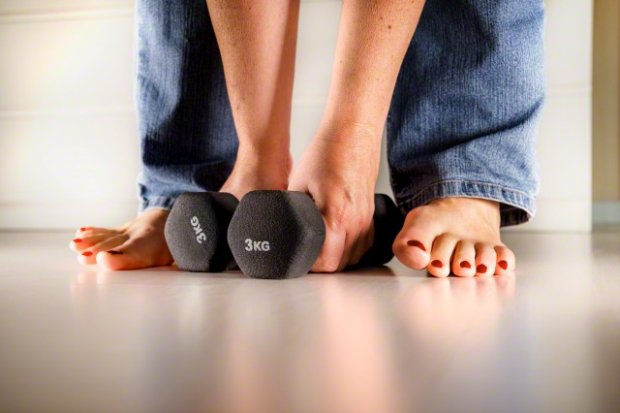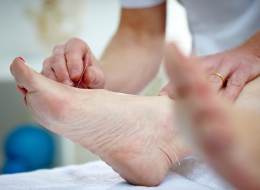Instant Relief Proven Ways to Reduce and Relieve Bunion Pain Without Surgery
Paul Bunyan was larger than life, so perhaps that’s why bunions are named as they are. As anyone with the condition knows, the pain that comes along with a bunion is also larger than life. In fact, it can be downright excruciating. Fortunately, there are a number of simple methods, like foot soaks and massages, that can ease bunion pain without the need for surgery.
Forget about speed bumps. The bumps that can really slow you down are abnormal nodules that jet out at the base of your big toes. Doctors call the condition hallux abducto valgus, but the rest of us simply use the term bunion. The bony bumps form when pressure is applied to the side of the big toe, which irritates the joint and forces it out of place. The big toe begins to angle toward the second toe, resulting in an often-painful lump that is sometimes coupled with redness and swelling.
At-Home Treatment of Bunion Pain
Wearing high heels and tight shoes are generally the main causes of bunions, though they can also develop as a result of hereditary factors, stress on the foot and medical conditions like arthritis. Unfortunately, most bunions are permanent unless corrected or removed with surgery. However, there are a number of simple tricks and methods that help to reduce and relieve bunion pain when surgery is not an option.
Purchase Properly Fitted Footwear
For many people, purchasing and wearing properly fitted shoes can greatly reduce the pain caused by bunions. In some cases, wearing the right footwear can eliminate bunion pain altogether. Opt for low-heeled shoes made of comfortable, flexible materials that provide plenty of room for your toes. One way to ensure you are wearing properly fitted shoes is to measure your feet, which you can learn to do via our foot measuring guide.
Use Shoe Inserts to Your Advantage
Certain shoe inserts can help position the foot into its intended placement, helping to ease the pain bunions create. You can purchase over-the-counter inserts and arch supports as well as orthoses prescribed by a doctor.
Indulge in Relaxing Foot Baths
Not only are foot soaks ultra relaxing, they can go a long way in reducing bunion pain and soothing sore, irritated feet. Start with either cool or warm water — your choice — and a few tablespoons of Epsom salt. Soak the affected foot for about 15 minutes per day to help with bunion discomfort.
Try Bunion Protection
Sometimes simply covering the bunion with a moleskin or gel-filled pad can help reduce the pain caused by the condition. You can find such bunion protection in most drugstores.
Stretch and Exercise Your Toes
It’s not usually at the top of the list of body parts people look to improve at the gym, but working out the toes with a variety of stretches and exercises is a great way to naturally ease bunion pain. Try these beneficial foot stretches, exercises and yoga poses as a way to relieve bunion discomfort.
Massage the Pain Away
Massaging your bunion is a simple and relaxing way of reducing both the problem and the pain. Rubbing your bunion 10 minutes per day is a good way to increase circulation and blood flow in the area, and it also encourages movement of the synovial fluid around the joint. Massage has been able to significantly reduce bunion size in many sufferers.
Apply a Topical Analgesic
In addition to other methods, applying a topical analgesic to your bunions can greatly reduce pain. There are a number of gels and creams on the market specifically designed to deliver pain relief. Many of them contain either cooling menthol or capsaicin, a compound derived from chili peppers that temporarily blocks pain signals wherever it is applied.
Try a Relief Splint or Toe Spacer
For serious bunion pain, you may want to consider trying a splint, a toe spacer or a bunion sleeve. Splints help hold the toe in a straighter position, toe spacers help realign the toes and prevent them from pressing together, and sleeves help protect the prominent bump from shoe friction.
Maintain a Healthy Weight
It may seem silly, but maintaining a healthy, normal weight can go a long way in reducing bunion pain. The joints at the base of your big toes carry most of your weight as you’re walking, so the less weight you put on your toes, the less pain you’re likely to feel.
Though there are many non-surgical bunion treatment options, it is best to consult with your doctor before deciding whether or not forgoing surgery is the right option for you.
Notice concerning medical entries:
Articles having medical content shall serve exclusively for the purpose of general information. Such articles are not suitable for any (self-) diagnosis and treatment of individual illnesses and medical indications. In particular, they cannot substitute for the examination, advice, or treatment by a licensed physician or pharmacist. No replies to any individual questions shall be effected through the articles.







